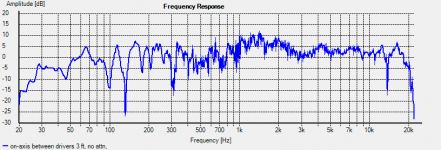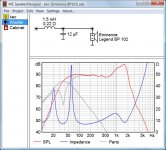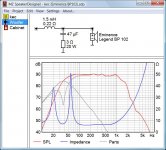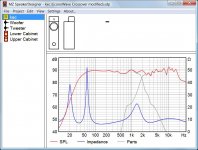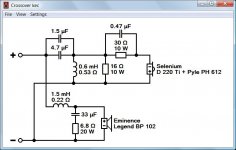Will you build in the waveguides or leave them mostly open kec? The speakers look seriously fun. Would closing them in would help or hinder?
I'll leave the waveguides open for now. I'm going to try the QSC clone waveguide which is 14" W X 10" H.
Here's my measurements on-axis 3 ft. from mic. No attenuation on tweeter.
Years ago I measured a stock A25 in an anechoic chamber with a B&K mic and
a swept frequency to a chart recorder. The response was otherwise good, but
there was a deep null on the tweeter axis at the crossover frequency.
Do you get a null if there's no averaging?
Years ago I measured a stock A25 in an anechoic chamber with a B&K mic and
a swept frequency to a chart recorder. The response was otherwise good, but
there was a deep null on the tweeter axis at the crossover frequency.
Do you get a null if there's no averaging?
Here's the raw response...
Attachments
Last edited:
Hi kec,
It's great you are doing a project with the Eminence Legend BP102. Cabinet and port dimensions are excellent, now you only need to get the crossover right and then the fun begins.
According to my simulation, the shunt capacitor of 12 uF in the woofer filter is responsible for the big hump at 1.5 kHz. A series resistor is urgently needed to damp that resonance. I get the best result with a shunt RC in the magnitude of 47 uF in series with 3 ohms.
Just to share my theoretical findings... 🙂
It's great you are doing a project with the Eminence Legend BP102. Cabinet and port dimensions are excellent, now you only need to get the crossover right and then the fun begins.
According to my simulation, the shunt capacitor of 12 uF in the woofer filter is responsible for the big hump at 1.5 kHz. A series resistor is urgently needed to damp that resonance. I get the best result with a shunt RC in the magnitude of 47 uF in series with 3 ohms.
Just to share my theoretical findings... 🙂
Attachments
hi Dissi - -what would you suggest for a lowpass network to tame Eminence's Delta10A's hump? (its in a Karlson type) - also I could use a better lowpass for Kappa12A - also in a little Karlson enclosure.
Thanks Dissi, this is exactly what I needed to know. How does the tweeter filter look? Any tweaks needed there?
BP102
Kec... nice work! Good to see some interest in this much overlooked woofer!
As for your mid band hump.... you can to keep it simple with a Zobel and the inductor, or do the full 2nd order as suggested, or you can get cute and do a B/W spread frequency. I would start with a +/- 15% spread centered on the peak of your midrange hump and see if that sums well. It too may require a Zobel. If that doesn't do the trick, a full +/- 30% spread may be required. Have not modeled it, so just guessing. Funny thing about frequency spreads is in some cases you need to switch polarities. This is usually driven by the woofer - tweeted horizontal offset distance. Will play with that angle once the toys arrive later this week.
Going to do a sealed version. With a typical RG of .7 ohm in a stuffed 1.4 cu ft box I should see a QTC of about .84 and an F3 around 48 Hz. With a raw woofer efficiency of about 91 db that's not too shabby!!
Kec... nice work! Good to see some interest in this much overlooked woofer!
As for your mid band hump.... you can to keep it simple with a Zobel and the inductor, or do the full 2nd order as suggested, or you can get cute and do a B/W spread frequency. I would start with a +/- 15% spread centered on the peak of your midrange hump and see if that sums well. It too may require a Zobel. If that doesn't do the trick, a full +/- 30% spread may be required. Have not modeled it, so just guessing. Funny thing about frequency spreads is in some cases you need to switch polarities. This is usually driven by the woofer - tweeted horizontal offset distance. Will play with that angle once the toys arrive later this week.
Going to do a sealed version. With a typical RG of .7 ohm in a stuffed 1.4 cu ft box I should see a QTC of about .84 and an F3 around 48 Hz. With a raw woofer efficiency of about 91 db that's not too shabby!!
Large Advent comparisons
Yes, this would be similar in size to the Large Advent with WAY better midrange and a more dynamic bottom end. But, the Large Advent had a F3 in the 40-44 Hz area depending when it was built. So better bass extension in a sealed box alignment. In a ported and much larger box, the BP102 can play flat into the 30's, besting the Large Advent bass extension.
The knocks on the Large Advent: Very low efficiency, about 85 db/watt (0.20 %) half space), low power handling midrange driver and very laid back presentation. The woofer did have some break up around 2K and only a single series inductor (1.6 mh) low pass crossover. Mainly due to it's bass extension, it was a popular speaker to be sure! I sold a few hundred pair back in the day!!
If you had enough power to drive them to a decent level the midrange often failed. One solution was to stack a pair near a corner (Tweeter to tweeter) and wire them in parallel. That got their sensitivity up to about 90 db/watt for the pair and with double the power handling, your tweeters would last awhile. The BP102 would still be slightly more efficient than the dual Large Advent, but again, at the sacrifice of low end extension.
Getting back to the BP102. The nice thing about it is how easy it is to shape it's roll off to match the HF driver you have, assuming your HF driver is at least 92 db efficient at it's least sensitive portion of it's operating range.
There are quite a few tweeters / compression drivers - horn assemblies that can work. As usual, it gets down to crossover and how much money you can justify spending.
Yes, this would be similar in size to the Large Advent with WAY better midrange and a more dynamic bottom end. But, the Large Advent had a F3 in the 40-44 Hz area depending when it was built. So better bass extension in a sealed box alignment. In a ported and much larger box, the BP102 can play flat into the 30's, besting the Large Advent bass extension.
The knocks on the Large Advent: Very low efficiency, about 85 db/watt (0.20 %) half space), low power handling midrange driver and very laid back presentation. The woofer did have some break up around 2K and only a single series inductor (1.6 mh) low pass crossover. Mainly due to it's bass extension, it was a popular speaker to be sure! I sold a few hundred pair back in the day!!
If you had enough power to drive them to a decent level the midrange often failed. One solution was to stack a pair near a corner (Tweeter to tweeter) and wire them in parallel. That got their sensitivity up to about 90 db/watt for the pair and with double the power handling, your tweeters would last awhile. The BP102 would still be slightly more efficient than the dual Large Advent, but again, at the sacrifice of low end extension.
Getting back to the BP102. The nice thing about it is how easy it is to shape it's roll off to match the HF driver you have, assuming your HF driver is at least 92 db efficient at it's least sensitive portion of it's operating range.
There are quite a few tweeters / compression drivers - horn assemblies that can work. As usual, it gets down to crossover and how much money you can justify spending.
how might 2 BP102 per cabinet be used vented with say the PRV (like QSC) waveguide and compression tweeter?
How does the tweeter filter look? Any tweaks needed there?
In my previous post I only addressed the woofer since I didn't model the tweeter section. Of course, the proposed filter modification only works properly if the tweeter response adds accordingly. 😀
In the meantime I did a search for the D220Ti and PH612 and found measurements published by Gainphile and Ampslab. Unfortunately, the curves differ significantly in low and top end and leave an uncertainty. The modeling of horn loaded compression drivers is also error-prone. So please do not overrate the results presented below. It's just a hint.
Anyway, modelling the complete speaker showed quickly that my first proposal creates a dip in the crossover range because the tweeter response falls too steeply and phase does not match either. Therefore, the shunt RC had to be adjusted and is now 33 uF in series with 6.8 ohms. Interestingly, these values are exactly those of a zobel, what John Busch has proposed as possibility.
In the tweeter section there's only the option to increase the capacitor. The value mainly affects the level at 3 kHz. With 4.7 uF I get a dip of 3 dB there.
Hope that helps and good luck. 🙂
Attachments
hope it is ok to ask in this tread
will the eminence bp102 be ok to use in a line array,,,6 pieces in a tower about 2m high
shall be used together with my LS9 line array
best Bjarne
will the eminence bp102 be ok to use in a line array,,,6 pieces in a tower about 2m high
shall be used together with my LS9 line array
best Bjarne
Hope that helps and good luck. 🙂
I made the changes and this is what it looks like now. The red is with the changes. And like before, no attenuation on the tweeter. 1/24 smoothing.
Thanks
Attachments
A bit late but here's an interesting kit from Visaton that fits the bill:
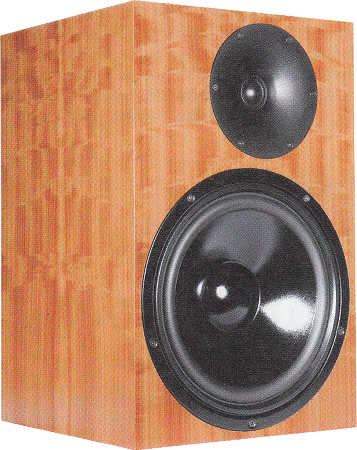
Further information can be found in HobbyHifi 5/2013 or here:
Hobby Hifi Chess - Speaker KIT without Cabinet Standard kaufen bei hifisound.de

Further information can be found in HobbyHifi 5/2013 or here:
Hobby Hifi Chess - Speaker KIT without Cabinet Standard kaufen bei hifisound.de
here's a project with that Visaton tweeter plus the wavegude
DIY 2-way Visaton - 8" WS20E + 1" G25FFL + WG WG148R
DIY 2-way Visaton - 8" WS20E + 1" G25FFL + WG WG148R
BP-102
Received the BP102's today in good shape. Looks like they are very close to advertised T/S specs. Hope to mock up a seal & stuffed 1.2 cu. ft. net box this weekend - early next week and get going on a crossover.
Received the BP102's today in good shape. Looks like they are very close to advertised T/S specs. Hope to mock up a seal & stuffed 1.2 cu. ft. net box this weekend - early next week and get going on a crossover.
Received the BP102's today in good shape. Looks like they are very close to advertised T/S specs. Hope to mock up a seal & stuffed 1.2 cu. ft. net box this weekend - early next week and get going on a crossover.
John, anything on this yet? I'm very interested in what you come up with.
- Status
- Not open for further replies.
- Home
- Loudspeakers
- Multi-Way
- 10" Two way, Seas A26 alternatives
